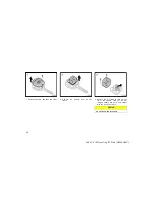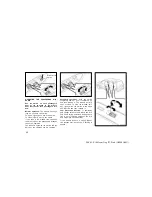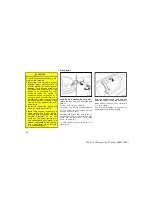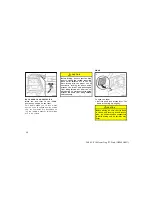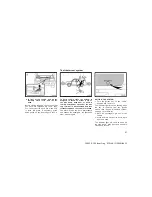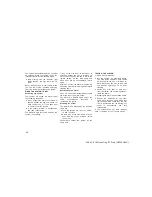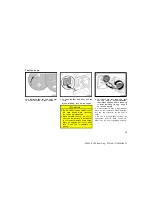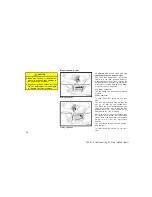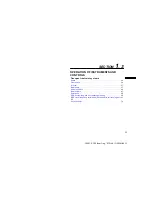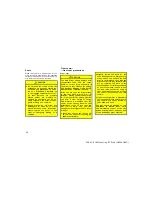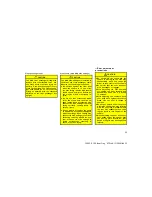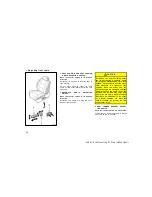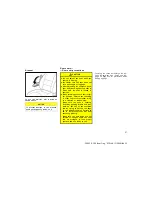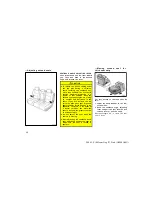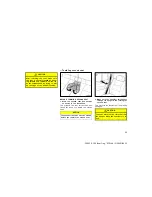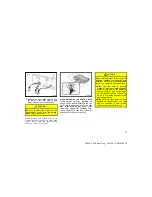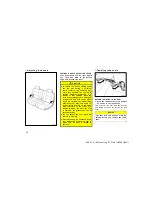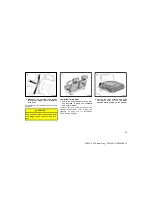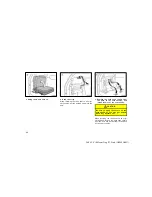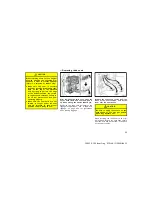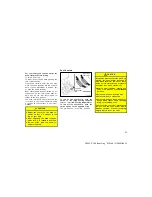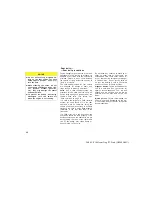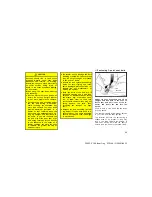
34
2004 L/C100 from Aug ’03 Prod. (OM60A04U)
Seats
While the vehicle is being driven, all ve-
hicle occupants should have the seatback
upright, sit well back in the seat and prop-
erly wear the seat belts provided.
CAUTION
Do not drive the vehicle unless the
occupants are properly seated. Do
not allow any passengers to sit on
top of a folded- down seatback, or
in the luggage compartment or car-
go area. Persons not properly
seated and/or not properly re-
strained by seat belts can be se-
verely injured in the event of emer-
gency braking or a collision.
During driving, do not allow any
passengers to stand up or move
around between seats. Otherwise,
severe injuries can occur in the
event of emergency braking or a
collision.
Driver seat
CAUTION
The SRS driver airbag deploys with
considerable force, and can cause
death or serious injury especially if
the driver is very close to the airbag.
The National Highway Traffic Safety
Administration (“NHTSA”) advises:
Since the risk zone for driver airbag
is the first 50- 75 mm (2- 3 in.) of
inflation, placing yourself 250 mm (10
in.) from your driver airbag provides
you with a clear margin of safety.
This distance is measured from the
center of the steering wheel to your
breastbone. If you sit less than 250
mm (10 in.) away now, you can
change your driving position in sever-
al ways:
Move your seat to the rear as far
as you can while still reaching the
pedals comfortably.
Slightly recline the back of the
seat. Although vehicle designs vary,
many drivers can achieve the 250
mm (10 in.) distance, even with the
driver seat all the way forward, sim-
ply by reclining the back of the
seat somewhat. If reclining the back
of your seat makes it hard to see
the road, raise yourself by using a
firm, non- slippery cushion, or raise
the seat if your vehicle has that
feature.
If your steering wheel is adjustable,
tilt it downward. This points the air-
bag toward your chest instead of
your head and neck.
The seat should be adjusted as rec-
ommended by NHTSA above, while
still maintaining control of the foot
pedals, steering wheel, and your view
of the instrument panel controls.
Front seats—
—Front seat precautions
Summary of Contents for 2004 LAND CRUISER 100
Page 8: ...8 2004 L C100 from Aug 03 Prod OM60A04U ...
Page 96: ...96 2004 L C100 from Aug 03 Prod OM60A04U ...
Page 106: ...106 2004 L C100 from Aug 03 Prod OM60A04U ...
Page 132: ...132 2004 L C100 from Aug 03 Prod OM60A04U ...
Page 150: ...150 2004 L C100 from Aug 03 Prod OM60A04U ...
Page 168: ...168 2004 L C100 from Aug 03 Prod OM60A04U ...
Page 200: ...200 2004 L C100 from Aug 03 Prod OM60A04U ...
Page 274: ...274 2004 L C100 from Aug 03 Prod OM60A04U ...
Page 283: ...283 2004 L C100 from Aug 03 Prod OM60A04U Fuse locations Spare fuses 1 Spare fuses ...
Page 302: ...302 2004 L C100 from Aug 03 Prod OM60A04U ...
Page 314: ...314 2004 L C100 from Aug 03 Prod OM60A04U ...
Page 333: ...viii 2004 L C100 from July 03 Prod OM60A04U ...
Page 337: ...AIR CONDITIONING 131 AIR CONDITIONING Automatic air conditioning controlss 132 SECTION V ...
Page 339: ...AIR CONDITIONING 133 UNX501 Air flow selection See Lower vent on page 139 V ...
Page 346: ...AIR CONDITIONING 140 ...
Page 380: ...ADVANCED FUNCTIONS 94 ...
Page 381: ...AUDIO SYSTEM 141 AUDIO SYSTEM Audio system 142 SECTION VI ...
Page 430: ...BASIC FUNCTIONS 18 ...
Page 472: ...DESTINATION INPUT AND ROUTE GUIDANCE 60 ...
Page 519: ...PASSPORT t o p e r f o r m a n c e 2004 Scheduled Maintenance Guide ...
Page 574: ...Toyota Maintenance and Repair Support 53 Notes ...
Page 575: ...Toyota Maintenance and Repair Support 54 Notes ...

